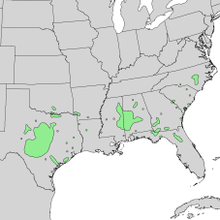Quercus sinuata
Quercus sinuata, the bastard oak,[3] bastard white oak,[4] or Durand oak,[4] is a North American species of oak. It is native to northern Mexico (Coahuila, Nuevo León, and Tamaulipas) as well as to the southeastern and south-central United States (from Texas and Oklahoma to the Carolinas).[4][5]
| Quercus sinuata | |
|---|---|
| Scientific classification | |
| Kingdom: | Plantae |
| Clade: | Tracheophytes |
| Clade: | Angiosperms |
| Clade: | Eudicots |
| Clade: | Rosids |
| Order: | Fagales |
| Family: | Fagaceae |
| Genus: | Quercus |
| Subgenus: | Quercus subg. Quercus |
| Section: | Quercus sect. Quercus |
| Species: | Q. sinuata |
| Binomial name | |
| Quercus sinuata | |
 | |
| Natural range of Quercus sinuata | |
| Synonyms[2] | |
|
List
| |
Description
Quercus sinuata is a deciduous tree up to 20 meters (67 feet) tall. Leaves are narrow, with shallow rounded lobes. It tends to grow in wet habitats, such as on river bluffs, river bottoms, and flatwoods, and generally over basic substrates, such as mafic rocks, shells, or calcareous sediment.[4][6]
Varieties
- Quercus sinuata var. breviloba (Torr.) C.H.Mull. - Texas, Oklahoma, Mexico
- Quercus sinuata var. sinuata - Alabama, Arkansas, Florida, Georgia, Louisiana, Mississippi, Carolinas, Texas
References
- "Quercus sinuata". IUCN Red List of Threatened Species. 2015. 2015. Retrieved 21 November 2017.
data
- "Quercus sinuata Walter". World Checklist of Selected Plant Families (WCSP). Royal Botanic Gardens, Kew – via The Plant List.
- "Quercus sinuata". Natural Resources Conservation Service PLANTS Database. USDA. Retrieved 15 September 2015.
- Nixon, Kevin C. (1997). "Quercus sinuata". In Flora of North America Editorial Committee (ed.). Flora of North America North of Mexico (FNA). 3. New York and Oxford – via eFloras.org, Missouri Botanical Garden, St. Louis, MO & Harvard University Herbaria, Cambridge, MA.
- "Quercus sinuata". County-level distribution map from the North American Plant Atlas (NAPA). Biota of North America Program (BONAP). 2014.
- Flora of the Southern and Mid-Atlantic States by Alan S. Weakley
This article is issued from Wikipedia. The text is licensed under Creative Commons - Attribution - Sharealike. Additional terms may apply for the media files.
